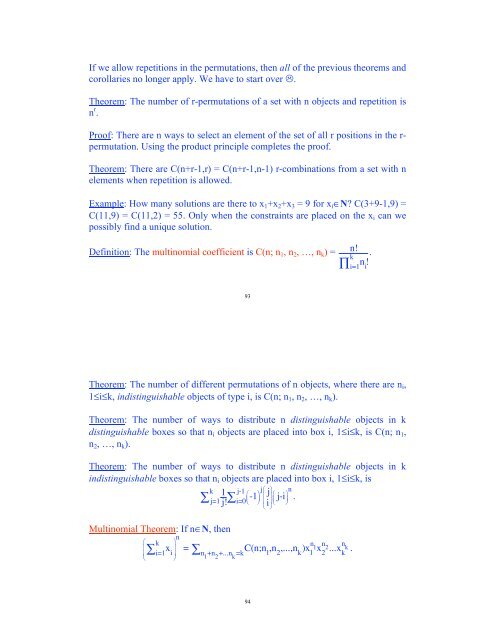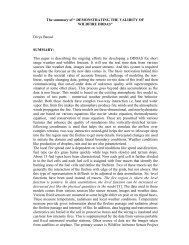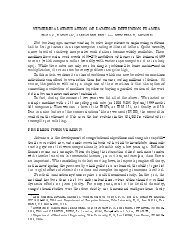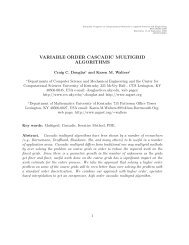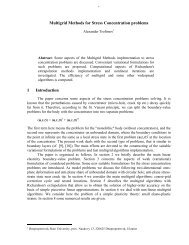Discrete Mathematics University of Kentucky CS 275 Spring ... - MGNet
Discrete Mathematics University of Kentucky CS 275 Spring ... - MGNet
Discrete Mathematics University of Kentucky CS 275 Spring ... - MGNet
You also want an ePaper? Increase the reach of your titles
YUMPU automatically turns print PDFs into web optimized ePapers that Google loves.
If we allow repetitions in the permutations, then all <strong>of</strong> the previous theorems and<br />
corollaries no longer apply. We have to start over !.<br />
Theorem: The number <strong>of</strong> r-permutations <strong>of</strong> a set with n objects and repetition is<br />
n r .<br />
Pro<strong>of</strong>: There are n ways to select an element <strong>of</strong> the set <strong>of</strong> all r positions in the r-<br />
permutation. Using the product principle completes the pro<strong>of</strong>.<br />
Theorem: There are C(n+r-1,r) = C(n+r-1,n-1) r-combinations from a set with n<br />
elements when repetition is allowed.<br />
Example: How many solutions are there to x 1 +x 2 +x 3 = 9 for x i ,N? C(3+9-1,9) =<br />
C(11,9) = C(11,2) = 55. Only when the constraints are placed on the x i can we<br />
possibly find a unique solution.<br />
Definition: The multinomial coefficient is C(n; n 1 , n 2 , …, n k ) = n!<br />
k<br />
! n i<br />
!<br />
.<br />
i=1<br />
93<br />
Theorem: The number <strong>of</strong> different permutations <strong>of</strong> n objects, where there are n i ,<br />
1;i;k, indistinguishable objects <strong>of</strong> type i, is C(n; n 1 , n 2 , …, n k ).<br />
Theorem: The number <strong>of</strong> ways to distribute n distinguishable objects in k<br />
distinguishable boxes so that n i objects are placed into box i, 1;i;k, is C(n; n 1 ,<br />
n 2 , …, n k ).<br />
Theorem: The number <strong>of</strong> ways to distribute n distinguishable objects in k<br />
indistinguishable boxes so that n i objects are placed into box i, 1;i;k, is<br />
k<br />
j=11<br />
j!<br />
Multinomial Theorem: If n,N, then<br />
"<br />
$<br />
$<br />
#<br />
!<br />
k<br />
i=1<br />
x i<br />
n<br />
%<br />
'<br />
'<br />
&<br />
j-1<br />
j"<br />
%<br />
j<br />
" %<br />
! -1 $ ' "<br />
! #<br />
$<br />
&<br />
' j-i<br />
i=0 $<br />
i'<br />
#<br />
$<br />
#<br />
&<br />
%<br />
& 'n<br />
.<br />
n<br />
= ! n1<br />
C(n;n 1<br />
,n 2<br />
,...,n<br />
+n 2<br />
+...n k<br />
)x 1<br />
n<br />
k<br />
=k<br />
1<br />
x 2<br />
n<br />
2<br />
...x k k<br />
.<br />
94


